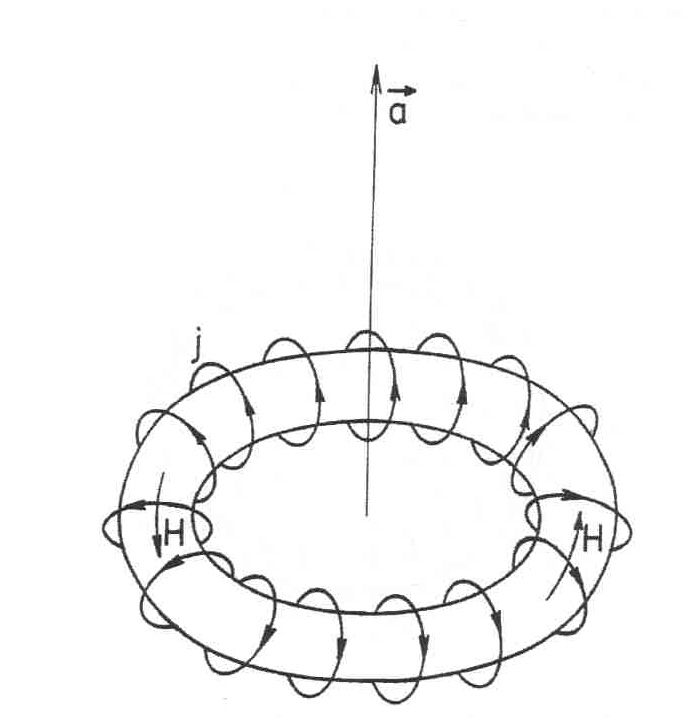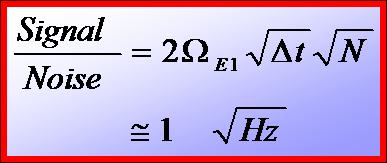|
Parity Violation
[ Page under construction ... more later ]
|
|
Proposed nuclear anapole moment measurement
The nuclear anapole moment of
francium is an order of magnitude larger than in cesium, the only atom in which
a non-zero moment has been measured [C. S. Wood et al., Science 275, 1759
(1997)]. We propose a measurement of the parity-violating nuclear anapole
moment of francium in a string of isotopes using an microwave cavity to drive
a forbidden hyperfine transition.
|
|
What's an anapole moment?
An anapole moment is a rarely considered classical
electromagnetic moment. The anapole is a
localized moment, which manifests itself as a contact interaction
. For a charged particles in an electromagnetic field, the
interaction with the anapole of the field occurs only at a single point.
A common example of an electromagnetic field with an anapole
moment is the field generated by a toroidal current : since
almost all of the electromagnetic energy is in the magnetic field inside the
torus, an electron will primarily interact with such field when it is inside
the torus. Part of that localized interaction can be described by an
interaction with a point-like anapole moment located at the
center of symmetry of the torus.
The interaction of a charge with an anapole moment is in
sharp contrast with the motion of a particle moving in an
electromagnetic field with a dipole moment: In this case, the charged particle
interacts with the dipole field at all points in space.
|
|

Example of a current distribution with an anapole moment: Toroidal current
[figure taken from V. V. Flambaum in Atomic Physics 16:
Sixteenth International Conference on Atomic Physics.,edited by W. E. Baylis
and G. W. F. Drake (AIP, 1998)].
|
|
The anapole moment
The anapole moment of an arbitrary current distribution, J(r),
is: 
The vector potential generated by an anapole moment a at
the origin is: 
The interaction potential of an electron with an anapole moment
a is: 
|
|
Parity non-conservation
The interaction energy between an electron and a
classical anapole moment is even
under a parity time-reversal transformations (in both
transformations: p Y -p,
J Y
-J). However, a circulating current also
implies angular momentum (L=r x
p), which is even under a parity
transformation (LY
L), with the anapole moment parallel to the angular
momentum (a //
L) -- in quantum mechanics this is also necessary
according to the Wigner-Eckart theorem. So from this second analysis,
the interaction energy is
odd under a parity transformation: the anapole
interaction violates the parity even symmetry of the hamiltonian.
In the nucleus, the spin and the circulating orbital motion of the
external nucleons generate the nuclear spin I and an
associated effective current. However, the weak force
introduces a small toroidal component to this orbital+spin
current, thus generating a parity violating anapole moment. The small
toroidal component is due to the exchange of the Z0 neutral weak
current between nucleons, which is represented in the Feynman diagram
below:

Feynman diagrams for the regular electron-nucleon interaction (left)
and the parity violating electron-anapole interaction (right)
|
|
Proposed measurement method
We propose to measure the anapole moment of francium nuclei
by searching for the induced parity non-conserving spin-dependent
transition amplitude between two hyperfine ground levels.
Parity mixing:
|

Parity forbidden E1 hyperfine transition
|
|
Since the hamiltonian is no longer a purely parity-even operator
due to the parity-odd anapole interaction, the energy eigenstates no longer
have a definite parity. More specifically, an |S,
state is now mostly even, but contains a little bit of an odd |P,
state contribution. Expanding the new "|S',"
state to 1st order in the parity conserving basis, we get

where DE is the energy
separation of the 7S1/2 and 7P1/2
levels (~817 nm), and eanapole
is an energy characterizing the anapole induced parity mixing. This parity
mixing means that a parity forbidden E1 transition
between hyperfine ground states is now possible.
|
|
Fundamental signal-to-noise
While the amplitude for such a transition is very small, it is
nevertheless observable. According to our calculations, such a transition
amplitude is an order of magnitude larger in francium than in cesium. The
proposed measurement is ultimately quantum projection noise limited. We
estimate that the signal-to-noise will be

Where W E1 is
the Rabi-frequency of the anapole-allowed E1 transition.
We have assumed a measurement on 106 francium atoms
in a microwave electric field of 1 kV/m. While the ultimate
signal-to-noise may appear small, it is large compared to standard
parity-violation measurements.
For more detailed information on the proposed measurement, please see
S. Aubin, E. Gomez, J. M. Grossman, L. A. Orozco, M. R. Pearson,
G. D. Sprouse, and D. P. DeMille
Francium spectroscopy and a possible measurement of the
nuclear anapole moment
ICOLS XV proceedings , ed. S. Chu, V. Vuletic, A. J.
Kerman, and C. Chin, World Scientific (2001).
[PDF]
E. Gomez, S. Aubin, G. D. Sprouse, L. A. Orozco, and D. P. DeMille
Measurement method for the nuclear anapole moment of laser
trapped alkali atoms
arXiv:physics/0412124 --
submitted to Phys. Rev. A.
For a good review of the nuclear anapole moment, please see
V. V. Flambaum in Atomic Physics 16: Sixteenth International
Conference on Atomic Physics.,edited by W. E. Baylis and G. W. F.
Drake (AIP, 1998).
|
|
|






